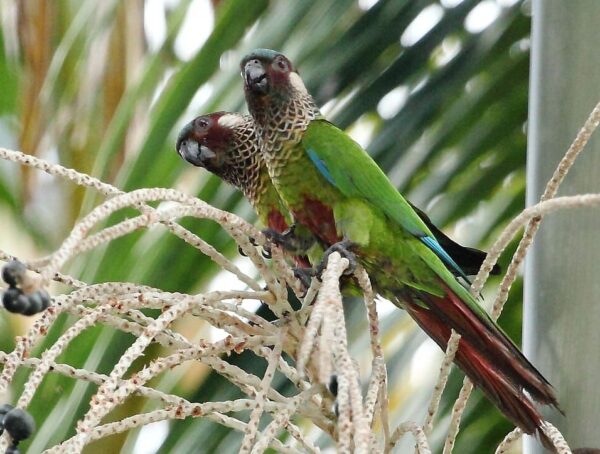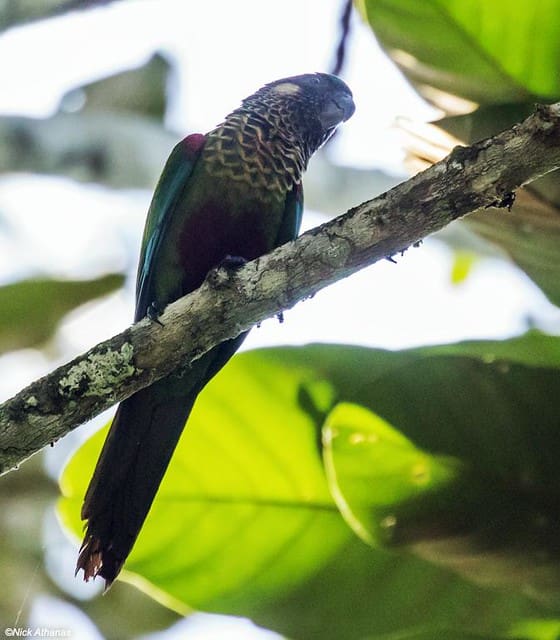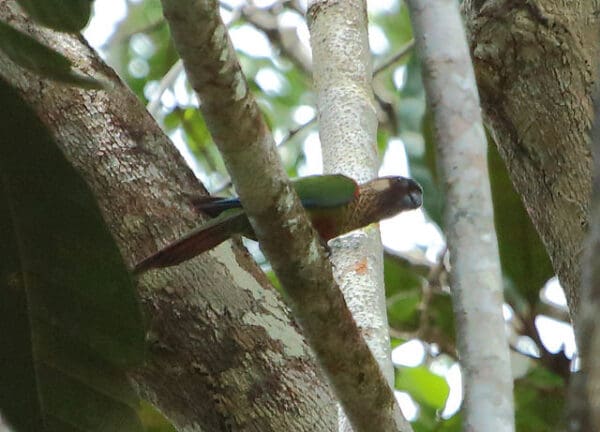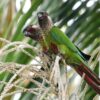Painted Conure
Also known as:
Painted Parakeet, Blue-winged Conure
Also known as:
Painted Parakeet, Blue-winged Conure
DID YOU KNOW?
The Painted Conure complex once comprised eight subspecies.

Pyrrhura

picta
Size:
22 cm (8.6 in)
Weight:
54-70 g (1.9-2.5 oz)
Subspecies including nominate:
one
Colour Adult:
Both adults dark brown crown to nape with blue wash on forecrown; brown/red face and area below eyes; off-white ear coverts; dusky brown upper breast scalloped with off-white; green/brown lower breast, scalloped with yellow/white; thin blue collar on hindneck; red bend of wing; brown/red patch on centre of abdomen; red/brown tail becoming green toward base. Beak dark brown/grey. Eye-ring bare and grey. Eye orange/brown.
Colour Juvenile:
Bend of wing green with scattered red feathers; brown/red patch on abdomen less extensive; shorter tail. Eye ring grey/white. Eye brown.
Call:
Calls made in flight described as coarse, rough and forceful; less harsh than that of other Pyrhurra sp.
More Information:
Content Sources:
CITES
BirdLife International
Cornell Lab of Ornithology/Birds of the World
Parrots: A Guide to Parrots of the World, Juniper and Parr, 1998
Parrots of the World, Forshaw and Cooper, 1977. 2010 edition
Parrots of the World, Forshaw, 2006.
Parrots in Aviculture, Low, 1992.
Lexicon of Parrots, Thomas Arndt.
Psittacine Aviculture, Schubot, Clubb and Clubb, 1992.
Captive Status:
Uncommon
Longevity:
13-15 yrs
Housing:
Aviary or suspended enclosure, minimum length 2 m (6.5 ft).
Diet:
Fruit such as: apple, pear, orange, cactus fruits, pomegranate, forming about 30 percent of diet; vegetables such as: carrot, celery, green beans and peas in the pod; fresh corn; green leaves such as: Swiss chard, lettuce, sowthistle, dandelion; spray millet; small seed mix such as: millet, canary, and smaller amounts of oats, buckwheat, safflower and a little hemp; soaked and sprouted sunflower seed; cooked beans and pulses, boiled maize and complete kibble.
Enrichment:
Enjoys bathing. Provide fresh, unsprayed branches; bird-safe chewables such as pine and fir block toys and vegetable tanned leather chew toys.
Nest Box Size:
Nest log or tree stump or vertical box 12″ x 12″ x 18″ (30.5 cm x 30.5 cm x 46 cm).
Clutch Size:
5-7
Fledging Age:
40-51 days
Hatch Weight:
—
Peak Weight:
—
Weaning Weight:
—
World Population:
Unknown, possibly decreasing.
IUCN Red List Status:
Least Concern
CITES Listing:
Appendix II
Threat Summary:
Declining in some areas due to deforestation and trapping for the wild bird trade.
Range:
Venezuela, south of Rio Orinoco, through Guianas to N Brazil.
Habitat:
Found up to 1200 m (3936 ft) in wooded habitats including riverine formations, mature evergreen forest and cloud forest.
Wild Diet:
Food items include fruits of Goupia glabra, Bagassa guianensis, Trema micrantha, Heisteria spruceana, Zanthoxylum rhoifolium, Cordia, Protium, Alchornea, Drypetes, Mimosa, Byrsonima, Dicella, Heteropterys, Cecropia, Ficus, Psidium, Pourouma, Eugenia and Euterpe. Also flowers and fruit of Cochlospermum orinocense and Symphonia globulifera, Allantoma lineata, Bertholletia excelsa, Dioclea glabra, flowers of Erythrina amazonica and seeds of Cecropia miparia; some reports of birds taking Diptera larvae.
Ecology and Behaviour:
Found in flocks of 10 or 15 birds. During breeding season seen in pairs and families. Feeds and rests in foliage of upper stages of canopy, where it is well camouflaged. Noisy in flight.
Clutch and Egg Size:
5-7 elliptical eggs, 26.5 x 19.0 mm (1 x 0.7 in).
Breeding Season:
December-February. Nest is in tree hollow.




![© Nick Athanas [CC BY-NC-SA 2.0] via Flickr A wild Painted Conure perches on a limb](https://gt2024.parrots.org/wp-content/uploads/2023/01/wpt_Painted-Conure_1344-2-100x100.jpg)
![© Feroze Omardeen [CC BY-NC-SA 2.0] via Flickr A wild Painted Conure perches on a limb](https://gt2024.parrots.org/wp-content/uploads/2023/01/wpt_Painted-Conure_1344-1-100x100.jpg)